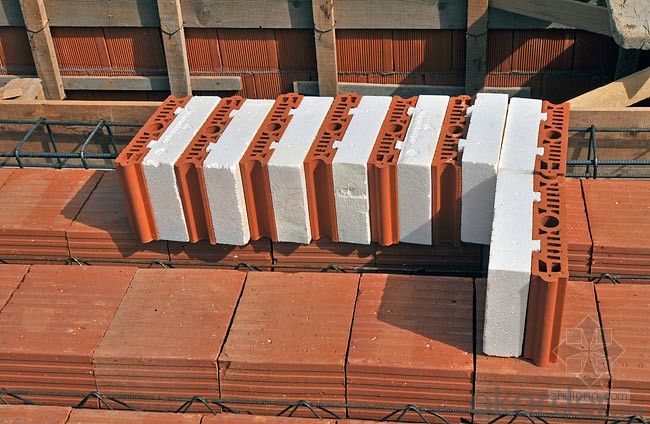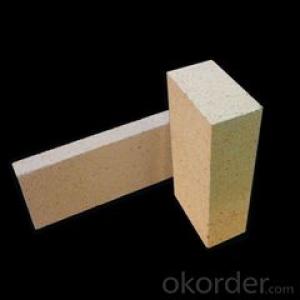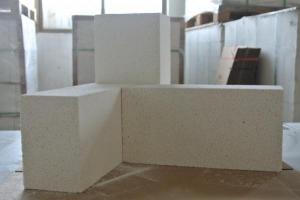Insulating Fire Brick - Refractory Mullite Insulating Refractory Brick JM 30
- Loading Port:
- Shanghai
- Payment Terms:
- TT OR LC
- Min Order Qty:
- 20 m.t.
- Supply Capability:
- 20 m.t./month
OKorder Service Pledge
OKorder Financial Service
You Might Also Like
General Information
CMAX insulating firebricks are classified under temperature between 1300℃ to 1700℃, manufactured from high purity alumina clay.
1. Lower content of iron, alkaline and impurities, good high temperature properties.
2. Homogeneous structure, light weight, energy saving because lower heat storage in the furnace during cooling cycles.
3. High strength, good thermal shock resistance under high temperature.
4. Precise sizes due to grinding and shaping after sintering, which meets the requirement of construction.
5. Max service temp: Up to 1730C (3160F)
Feature
Light weight and low thermal conductivity
Low heat storage
Low iron and impurities
High thermal shock resistance
Application of Insulating brick
Metallurgical Industry: blast furnace, hot blast furnace, heating furnace, etc..
Petrochemical Industry: ethylene cracking furnace, hydrogen furnace, the main furnace, heating furnace, etc..
Ceramic industry: roller kiln, kiln, etc..
Glass industry: glass furnace regenerator, etc.
Carbon industry: carbon furnace, etc..
Aluminum electrolysis industry: aluminum reduction cell, etc.
Other industries: tunnel kiln, shuttle kiln, etc.
Advantages of heat insulation brick
Low thermal conductivity: many air holes will bring good thermal insulation effect, energy saving.
High crushing strength: high crushing strength, volume stability.
Low heat storage: small heat storage, absorb more heat, energy-saving effect is obvious.
Technical Data
ITEM | GJM30 | GJM28 | GJM26 | GJM23 |
Classification Temperature, ℉/℃ | 3000/1650 | 2800/1540 | 2600/1430 | 2300/1260 |
Bulk Density,g/cm³ | ≤1.0 | ≤0.9 | ≤0.8 | ≥0.5 |
Reheating Linear Change, % | ≤0.9 (1550℃,12 h) | ≤0.8 (1510℃,12 h) | ≤0.7 (1410℃,12 h) | ≤0.5 (1230℃,12 h) |
Al2O3 Content, % | ≥75 | ≥65 | ≥55 | ≥45 |
Fe2O3 Content, % | ≤0.5 | ≤0.6 | ≤0.7 | ≤1.0 |
Thermal Conductivity: | ||||
800℃, w/m.k | ≤0.39 | ≤0.37 | ≤0.35 | ≤0.18 |
1000℃, w/m.k | ≤0.43 | ≤0.41 | ≤0.39 | ≤0.20 |
1200℃, w/m.k | ≤0.48 | ≤0.46 | ≤0.43 | --- |
Insulating brick


Common problem solution
1. What products do you have?
We have all kinds of refractory bricks, refractory casting materials, mortar, cement, ceramic fiber products, etc..
Or you can browse our products to choose what you need.
2. How to control product quality?
With strict quality control system throughout the material selection and production process, we have the quality of refractory materials and ceramic fiber products to meet customer requirements.
From the selection of raw materials, the quality of our control to start. The quality of the raw materials required for each batch of products in the use of the front line test. In the production process, through the quality control of workers, and then to each piece of classification, and through quality supervision and inspection.
3. Could you give me a brief introduction to the application of your product?
My Company is mainly engaged in steel, cement, glass, ceramics, petrochemical, electric power and other industries.
4. If I need you, what kind of information do you need?
In order to select the right products, we will provide us with information, such as the United States, technical data, order quantity, product applications, etc..
If you have any questions, please contact us.
- Q: Can insulating fire bricks be used in chimney lining?
- Yes, insulating fire bricks can be used in chimney lining. They are designed to withstand high temperatures and provide insulation, making them an ideal choice for lining chimneys to improve heat retention and prevent heat transfer to surrounding structures.
- Q: Can insulating fire bricks be used as a lining material for boilers?
- Yes, insulating fire bricks can be used as a lining material for boilers. Insulating fire bricks are designed to withstand high temperatures and provide excellent insulation, making them suitable for use in boiler linings.
- Q: Are insulating fire bricks resistant to nitrogen oxides?
- Insulating fire bricks are renowned for their exceptional thermal insulation properties and are commonly utilized in high-temperature applications, such as furnaces, kilns, and industrial boilers. Despite their remarkable heat resistance and ability to endure extreme temperatures, their resistance to nitrogen oxides (NOx) can vary based on the bricks' specific composition and manufacturing process. Nitrogen oxides encompass a group of harmful gases generated during combustion processes, particularly at elevated temperatures. These gases can have adverse effects on both human health and the environment. Even though insulating fire bricks possess a high melting point and can endure intense heat, they may not provide adequate resistance to nitrogen oxides independently. To enhance the resistance of insulating fire bricks against nitrogen oxides, additional measures and coatings may be necessary. These measures could involve the application of specialized refractory coatings or the inclusion of specific additives during the manufacturing process to create bricks that are more chemically resistant. It is essential to acknowledge that the resistance of insulating fire bricks to nitrogen oxides may also depend on the specific application and operating conditions. Different types of nitrogen oxides, such as nitrogen dioxide (NO2) or nitric oxide (NO), may have varying effects on the bricks. Therefore, it is advisable to consult the manufacturer or a refractory materials specialist to determine the suitability of insulating fire bricks in a particular environment where the presence of nitrogen oxides is of concern.
- Q: Can insulating fire bricks be used in the construction of furnaces?
- Yes, insulating fire bricks can be used in the construction of furnaces. Insulating fire bricks are specially designed bricks that have high insulating properties, allowing them to withstand high temperatures while minimizing heat loss. These bricks are made from lightweight materials such as clay, silica, and alumina. They have a low thermal conductivity, which means they can effectively maintain heat within the furnace while preventing the outer surface from becoming too hot. This makes them ideal for lining the walls, roof, and floor of furnaces, helping to increase energy efficiency and reduce fuel consumption. Additionally, insulating fire bricks are resistant to thermal shock, making them highly durable and long-lasting in the harsh conditions of a furnace. Overall, insulating fire bricks are a popular choice for furnace construction due to their excellent insulating properties and ability to withstand high temperatures.
- Q: Can insulating fire bricks be used as a refractory lining material?
- Yes, insulating fire bricks can be used as a refractory lining material. Insulating fire bricks have excellent thermal insulation properties and can withstand high temperatures, making them suitable for applications where heat retention and energy efficiency are important. They are commonly used in furnaces, kilns, and other high-temperature industrial equipment as a lining material to prevent heat loss and protect the surrounding structures.
- Q: Can insulating fire bricks be used in the construction of reheat furnaces?
- Yes, insulating fire bricks can be used in the construction of reheat furnaces. These bricks are designed to have high insulating properties, which helps to minimize heat loss and improve energy efficiency in the furnace. Additionally, their lightweight nature makes them easier to handle and install.
- Q: How to do indoor thermal insulation
- Indoor thermal insulation, as well as "folk prescription""Some owners also used some of the insulation sleeves, for example, light reflection, heat is also, by means of a reflected heat, indoor temperature increase, the specific approach is adopted, Kouban metal surface, can also use the kitchen stove using metal film or metal film for baking food, installed in the radiator the walls and the walls, so that the heat preservation and reflection cooling effect, but also does not affect the appearance. Again, the 40% heat and window glass heat loss on indoor winter, especially some French families, the feeling of winter indoor temperature is relatively low, methods can be used to paste glass insulation film and coated glass insulation coating to retain heat.
- Q: Can insulating fire bricks be used in brick kilns?
- Yes, insulating fire bricks can be used in brick kilns. Insulating fire bricks are designed to have high thermal resistance, which makes them an ideal choice for insulating the walls of a brick kiln. These bricks can withstand extremely high temperatures and help to maintain consistent heat levels within the kiln. By using insulating fire bricks, the heat loss from the kiln is minimized, resulting in improved energy efficiency and reduced fuel consumption. Additionally, the use of insulating fire bricks can also help to protect the outer layers of the kiln from excessive heat, preventing damage and prolonging the lifespan of the kiln. Overall, insulating fire bricks are a suitable and effective choice for use in brick kilns.
- Q: Can insulating fire bricks be used in wastewater treatment plants?
- Yes, insulating fire bricks can be used in wastewater treatment plants. Insulating fire bricks are designed to withstand high temperatures, making them suitable for use in various industrial applications, including wastewater treatment plants. They are commonly used in the construction of kilns, furnaces, and other high-temperature equipment. In wastewater treatment plants, insulating fire bricks can be used in the construction of incinerators, thermal oxidizers, and other systems that require high-temperature insulation. Their properties, such as high thermal resistance, low thermal conductivity, and excellent insulation capabilities, make them ideal for maintaining the desired temperatures in these systems while minimizing heat loss. Additionally, insulating fire bricks are resistant to chemical attacks, which is important in wastewater treatment plants where various chemicals and corrosive substances are present. Overall, the use of insulating fire bricks in wastewater treatment plants can help improve energy efficiency, reduce maintenance costs, and ensure the longevity of high-temperature equipment.
- Q: Can insulating fire bricks be used for insulation in chemical storage tanks?
- Indeed, insulation in chemical storage tanks can be achieved by utilizing insulating fire bricks. These bricks, purposefully engineered to offer exceptional thermal insulation, lend themselves well to a wide range of industrial uses, including chemical storage tanks. Their outstanding insulating properties stem from their low thermal conductivity, ensuring minimal heat transfer and a consistent internal temperature within the tank. Moreover, these fire bricks exhibit remarkable resistance to high temperatures and the corrosive effects of various chemicals, rendering them a fitting option for insulation in chemical storage tanks.
Send your message to us
Insulating Fire Brick - Refractory Mullite Insulating Refractory Brick JM 30
- Loading Port:
- Shanghai
- Payment Terms:
- TT OR LC
- Min Order Qty:
- 20 m.t.
- Supply Capability:
- 20 m.t./month
OKorder Service Pledge
OKorder Financial Service
Similar products
Hot products
Hot Searches
Related keywords





























